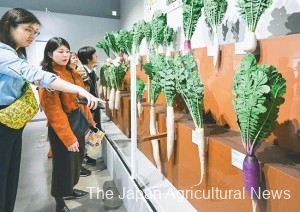TOKYO, Dec. 17 — Slim, long, round, red, big — the replicas of 25 local daikon radish varieties from across Japan is attracting attention of visitors at the National Museum of Nature and Science in Tokyo’s Taito Ward.

Visitors to the National Museum of Nature and Science in Tokyo’s Taito Ward look at replicas of various daikon varieties.
The display is the main feature of a special exhibition on washoku Japanese cuisine that illustrates how the unique culture of Japanese food was formed, from various perspectives including science and history.
The exhibit was organized to commemorate the 10-year anniversary of washoku’s inclusion in the list of intangible cultural heritage by the United Nations Educational, Scientific and Cultural Organization (UNESCO) in 2013. It is supported by the Ministry of Agriculture, Forestry and Fisheries and others.
Daikon is often used in Japanese cooking and the number of daikon varieties cultivated in Japan is the largest in the world.
The exhibition showcases life-size replicas of daikon radish of all shapes and sizes, including Moriguchi Daikon, a variety mainly cultivated in Gifu and Aichi prefectures that grows to as long as 1.8 meters; Iwakuni Aka Daikon, a round variety with a bright red skin cultivated in Yamaguchi Prefecture; and Sakurajima Daikon, a variety cultivated in Kagoshima Prefecture that has been recognized in the Guinness Book of Records as the world’s biggest and heaviest daikon.
“Japanese people love daikon,” says an official of the museum. “Varieties that match the tastes and climate of various places in the country have been cultivated until now.”
The exhibition, which runs until Feb. 25 next year, also displays the mechanism of fermentation, as well as the reproduced meals of Himiko, a 3rd-century semi-legendary shamaness-queen of Japan, and Tokugawa Ieyasu, the founder of the country’s last shogunate — the Tokugawa, or Edo, shogunate (1603-1867).

